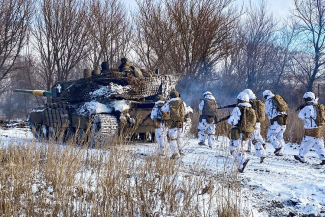Ukrainians try to regain initiative in Kursk Oblast. Day 1049 of the war


On 5 January, Ukrainian forces struck north-east of Sudzha in the Kursk Oblast and advanced – depending on the source – between 3 and 7 km along the Sumy-Kursk road. The advance was halted in the area of the village of Berdin, where fighting continues. At the same time, the Russians pressed forwards in three other directions in the Kursk Oblast, achieving the greatest success south-east of Sudzha. Their positions are now 2 km south of this town – the main logistical hub in the Ukrainian-controlled part of the oblast.
The direction of the Ukrainian strike indicates that the shift to offensive action was motivated primarily by political factors. The incursion kilometres deeper into Kursk Oblast does not improve the situation for the defenders. It remains an open question whether the Ukrainian command will attempt to break through the enemy’s defences in the Berdin area or launch another strike in a different direction. Either move carries risks – an attempt to show initiative, most likely linked to the upcoming inauguration of Donald Trump’s presidency, does not guarantee much success at the moment and depletes the Ukrainians’ potential and reduces their ability to defend themselves.
Russian troops have advanced to the western outskirts of Kurakhove, but isolated centres of Ukrainian resistance remain in its industrial part. Whether the defenders remaining in the city will manage to evacuate and to what extent remains to be seen. Indeed, in the current situation, it is unrealistic for the local Ukrainian command to gather the forces needed to unlock them and possibly continue their defence. The Russians have also made further advances south and south-west of Pokrovsk and north and west of Velyka Novosilka, but they have probably still not managed to physically cut the last supply route to the latter town. They also resumed offensive operations towards the road junction on the main road from Pokrovsk to the north of the Donetsk Oblast, to which they had about 2km left after seizing the main centre of Ukrainian resistance in Vozdvyzhenka.
Russia pushed the defenders to the northern and north-western edges of Toretsk and, according to some sources, split the forces resisting within its borders into two groupings. They extended bridgeheads on the western banks of the Zherebets River – towards Lyman – and the Oskil River – north of Kupiansk, as well as a breach in enemy positions south of the latter. More quarters in the centre of Chasiv Yar came under Russian control, while the defenders are thought to have recaptured some positions south of that town.

On 31 December and 1 January, the Russians struck Kyiv, causing apparent problems for Ukrainian air defence for the first time. The missile attack on the last day of 2024 was most likely directed against military installations. Residual communications from the Air Force Command and General Staff indicate that at least some of the missiles reached their targets (six of the 21 missiles used are thought to have been shot down, with about half of them hitting the capital). On New Year’s Day, the centre of Kyiv (Pecherskyi District) was attacked by strike drones, causing damage to buildings housing the central institutions of the state, including the Verkhovna Rada.
It cannot be ruled out that the repeated pinpoint attacks on the capital over the previous months have weakened its air defence system, and that the New Year’s strike was a demonstration of Russia’s capabilities. Indeed, the damage to the centre would have been much worse had they used missiles rather than drones, which are much harder to shoot down and have greater explosive potential. The results of the recent Russian strikes on infrastructure also make it possible to assume that the further Patriot launchers and other Western air defence systems acquired by Ukraine in late 2024 were more likely needed to supplement the losses suffered than to increase the defenders’ capabilities.
The intensity of Russian attacks on Chernihiv and Sumy oblasts has increased again. Their targets included critical infrastructure, and damage was reported on 31 December (in both oblasts), 3 January (rockets hit Chernihiv’s outskirts) and 5 January (near Sumy). In addition, rockets struck Bilhorod-Dnistrovskyi (31 December), Mykolaiv (1 January) and Zaporizhzhia Oblast (3 January). Kyiv Oblast, on the other hand, was a constant target for Russian drones, being attacked almost every day except 5 January. Drone damage was also reported in Poltava (5 and 6 January), Kharkiv and Zaporizhzhia (5 January) and the Cherkasy Oblast (6 January). From the evening of 30 December until the morning of 7 January, Russia is thought to have used a total of 728 strike drones and 51 missiles. Ukraine declared 461 drones and 11 rockets shot down, while 257 drones were described as locally lost.

On 31 December, Ukrainian Magura V5 surface drones destroyed aerial targets for the first time – two Russian Mi-8 helicopters off the coast of Crimea. This was made possible by installing anti-aircraft missile launchers on the drones. The evolution of the use of surface drones has been necessitated by the enemy’s development of methods to counter attacks using them, and helicopters are mainly being used to destroy them. In previous weeks, the Ukrainians tested drones with heavy machine guns installed on them, but they had little effect. Originally, Russian ships were the main target of surface drones, but over time it has become increasingly difficult for them to succeed (the most recent – the sinking of the ‘Sergey Kotov’ corvette – took place in March 2024). It cannot be ruled out that Ukrainian forces will again seek to create a threat to the enemy Black Sea Fleet by simultaneously using two specialised types of drone: one adapted to attack vessels and the other to attack aerial targets.
With less success, the Ukrainians continued their attacks on Russian territory. A drone strike on 31 December resulted in a fire at a fuel depot in Smolensk Oblast, while an attack on Crimea failed to produce a result (the aforementioned downing of helicopters was an exception). On 4 January, the targets of the attack included the port of Ust-Luga in the Leningrad Oblast (two days later, the Ukrainian media, citing the SBU, reported that a gas condensate tank had been hit), and on 6 January – with no apparent effect – the Millerovo and Taganrog airports in the Rostov Oblast.

On 2 January, the Office for Foreigners of the Republic of Poland announced that some Ukrainian citizens residing in Poland had received fake letters resembling a mobilisation summons. They indicated that due to Ukrainian legislation on military service and ongoing mobilisation in Ukraine, the recipient should expect a visit from representatives of the Polish office, who would bring the individual summoned to the mobilisation point of the Ukrainian Armed Forces. A day later, Ambassador Vasyl Bodnar stated that the false summonses were probably a Russian disinformation operation. He stated that most of the letters were transmitted via the Telegram messaging service, and noted that a voluntary recruitment drive for the Ukrainian Legion was underway in Poland, and that the recorded operation could serve to disrupt the implementation of this initiative.

In December 2024, the Ministry of Defence of Ukraine placed an order for 180,000 rounds of 35 mm calibre ammunition for the Gepard self-propelled anti-aircraft guns, the executing company Rheinmetall announced on 6 January. The cost of the missiles is being covered by Germany. In turn, the allocation of 300 million kroner ($27.1 million) to support Ukrainian air defence was announced on 3 January by the Swedish Defence Ministry.

On 1 January, statutory changes came into force regarding compulsory military training, which will replace basic military service, which has been suspended for the duration of the war. All men between the ages of 18 and 24 will have to undergo three months’ training. Failure to undergo this obligation will render them ineligible for employment in the state administration (including the police and the prosecutor’s office) or in local government bodies. In turn, on 1 September, basic military training – compulsory for men and optional for women – will be introduced into the curricula of all universities. The programme provides for the acquisition of the skills necessary for military service (handling weapons and the use of explosives, battlefield tactics, first aid).
On 30 December, 189 people (including defenders of Mariupol, the Chernobyl nuclear power plant and Snake Island) returned to Ukraine in a 1-for-1 exchange of captives. Since the beginning of the aggression, 3,956 people have left captivity.
Also on 30 December, Volodymyr Zelensky appointed Olha Reshetylova – the co-founder of the ‘Return to the Living’ foundation, a journalist covering human rights violations at the front and a coordinator of the ‘Media Initiative for Human Rights’ foundation – as presidential representative for the protection of soldiers’ rights. She will take up the position after she has drafted and enacted a law on an ombudsman for soldiers. According to her, it will deal exclusively with the protection of the rights of soldiers on active duty, and issues of conscripts’ rights will continue to reside with the Human Rights Ombudsman, while veterans’ affairs will continue to be handled by the Veterans Affairs Ministry.
On 31 December, the editor-in-chief of Censor.net Yurii Butusov revealed information about irregularities in the 155th “Anne of Kyiv” Mechanised Brigade, which was formed with French support. In December, it was sent to fight in the Pokrovsk region, where it suffered heavy losses. The bad situation in the unit was shown by the opening of an investigation by the State Bureau of Investigation into cases of abuse of power and desertion. The formation of the brigade began last March in Ukraine – manning was to be provided by the ‘West’ Operational Command. According to Butusov, however, the organisational work was chaotic, there was a lack of qualified commanders and most soldiers lacked combat experience. Last October, 1,924 soldiers were sent to a training camp in France (a total of 2,300 brigade soldiers were trained by the French), of whom only 51 had more than a year of service, 459 had less than a year, and most had less than two months. Some 50 men deserted from the unit during the training, and brigade commander Dmytro Riumshyn was dismissed. Moreover, some of the soldiers intended to replenish it (more than 2,500 men) were sent as reinforcements to other units, which reduced its combat value. Butusov stressed that the brigade had not been equipped with the necessary weapons (including drones), and that some of its armament – such as CAESAR howitzers – had gone to other units. He also pointed out that some 1,700 men had taken unauthorised abandonment since last spring. Butusov accused the civil and military authorities of sending a unit unprepared for combat to the front, who treated its formation as an ‘ill-considered propaganda move’.
In response to the allegations, on 2 January Defence Minister Rustem Umerov announced a comprehensive inspection of the Land Forces command, including an analysis of the organisational structure, an assessment of its management effectiveness and personnel policy. On 5 January, President Zelensky was to place the investigation of the situation in the 155th Mechanised Brigade under his personal supervision, including an examination of the circumstances and causes of mass desertions, while Commander-in-Chief Oleksandr Syrskyi announced that he would “pay attention” to the state of the unit’s equipment with drones.
The scandal over irregularities during the formation of the brigade is a symptom of a progressive personnel and organisational crisis in the Land Forces. The biggest problems are the insufficient training of soldiers with no combat experience, the shortage of commanders and the weakening of the newly formed unit due to its personnel being diverted as replacements to other brigades.
Mistakes made by the military could negatively impact further support for the organisation of new units by Western countries. Until the affair came to light, the Ukrainian government had suggested that the West was responsible for the slow training and equipping of the new brigades. At the end of November, Zelensky claimed that Western partners had only equipped two and a half of the ten brigades being formed and cited ‘bureaucracy’ among the reasons for delays in fulfilling promises.





